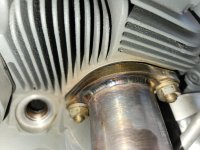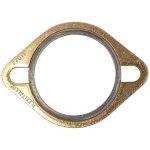All four of the exhaust flanges on my IO390EXP119 engine have a minimal amount of grey residue on the cylinders where the exhaust pipes attach to the bottom of the cylinders.
I've checked the torque on all the nuts and have been using the lock washers as well (checked torque at least 3 or 4 times since new -- engine now has 50 hours on it). Oh and I'm using the Lycoming 77611 gaskets.
I had an A&P look at it in person and was told that this amount of exhaust gas blow by was 'normal'.
A photo of one of the areas in question is attached.
I wanted to see if this group had any thoughts!
Thanks!!
I've checked the torque on all the nuts and have been using the lock washers as well (checked torque at least 3 or 4 times since new -- engine now has 50 hours on it). Oh and I'm using the Lycoming 77611 gaskets.
I had an A&P look at it in person and was told that this amount of exhaust gas blow by was 'normal'.
A photo of one of the areas in question is attached.
I wanted to see if this group had any thoughts!
Thanks!!







